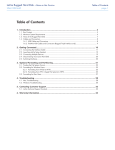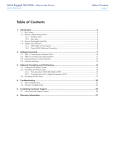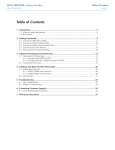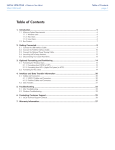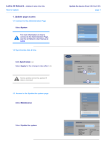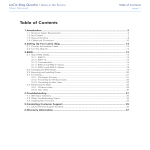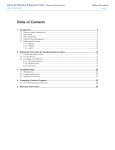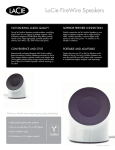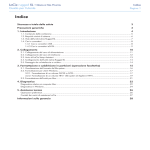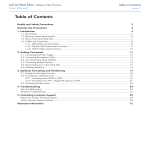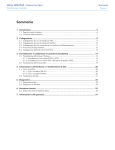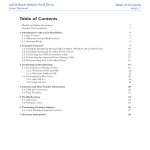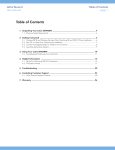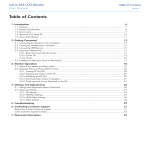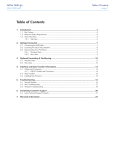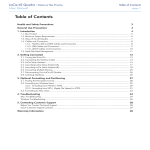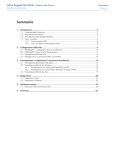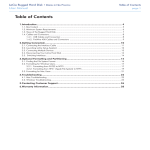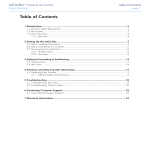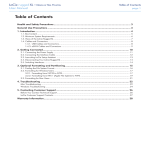Download Table of Contents - LaCieStorage.com
Transcript
LaCie Rugged Hard Disk • Design by Neil Poulton User Manual Table of Contents page 1 Table of Contents 1.Introduction................................................................................................................... 4 1.1. 1.2. 1.3. 1.4. Box Content..................................................................................................................................... 5 Minimum System Requirements.......................................................................................................... 6 Views of the Rugged Hard Disk.......................................................................................................... 7 Cables and Connectors..................................................................................................................... 8 1.4.1. USB Cables and Connectors.................................................................................................... 8 1.4.2. FireWire 400 Cables and Connectors (Rugged Triple Interface only)............................................ 9 2. Getting Connected....................................................................................................... 10 2.1. 2.2. 2.3. 2.4. 2.5. 2.6. 2.7. Connecting the Interface Cable ....................................................................................................... 11 LaCie Setup Assistant...................................................................................................................... 12 Launching LaCie Setup Assistant (A) ................................................................................................. 14 Launching LaCie Setup Assistant (B) ................................................................................................. 15 Connecting Multiple Devices............................................................................................................ 22 Disconnecting Your LaCie Hard Disk................................................................................................ 23 Switching Interfaces......................................................................................................................... 23 3. Optional Formatting and Partitioning.......................................................................... 24 3.1. Finding the File System Format......................................................................................................... 25 3.2. Formatting for Windows Users......................................................................................................... 26 3.2.1. Formatting from FAT32 to NTFS............................................................................................. 26 3.2.2. Formatting from HFS+ (Apple File System) to NTFS.................................................................. 28 3.3. Formatting for Mac Users................................................................................................................ 30 4.Troubleshooting.......................................................................................................... 31 4.1. Mac Troubleshooting...................................................................................................................... 31 4.2. Windows Troubleshooting................................................................................................................ 33 5. Contacting Customer Support...................................................................................... 35 5.1. LaCie Technical Support Contacts.................................................................................................... 36 6. Warranty Information.................................................................................................. 37 LaCie Rugged Hard Disk • Design by Neil Poulton User Manual Copyrights Copyright © 2011 LaCie. All rights reserved. No part of this publication may be reproduced, stored in a retrieval system, or transmitted in any form or by any means, electronic, mechanical, photocopying, recording or otherwise, without the prior written consent of LaCie. Trademarks Apple, Mac, and Macintosh are registered trademarks of Apple Computer, Inc. Microsoft, Windows 98, Windows 98 SE, Windows 2000, Windows Millennium Edition, Windows XP, Windows Vista, and Windows 7 are registered trademarks of Microsoft Corporation. Other trademarks mentioned in this manual are the property of their respective owners. Changes The material in this document is for information only and subject to change without notice. While reasonable efforts have been made in the preparation of this document to assure its accuracy, LaCie assumes no liability resulting from errors or omissions in this document, or from the use of the information contained herein. LaCie reserves the right to make changes or revisions in the product design or the product manual without reservation and without obligation to notify any person of such revisions and changes. Canada Compliance Statement This Class A digital apparatus meets all requirements of the Canadian InterferenceCausing Equipment Regulations. 110427v1.3 FCC Statement rugged Hard Drive Tested to comply with FCC standards for home or office use NOTE: This equipment has been tested and found to comply with the limits for a Class B digital device, pursuant to Part 15 of the FCC Rules. These limits are designed to provide reasonable protection against harmful interference in a residential installation. This equipment generates, uses and can radiate radio frequency energy and, if not installed and used in accordance with the instructions, may cause harmful interference to radio communications. However, there is no guarantee that interference will not occur in a particular installation. If this equipment does cause harmful interference to radio or television reception, which can be determined by turning the equipment off and on, the user is encouraged to try and correct the interference by one or more of the following measures: ✦✦ Reorient or relocate the receiving antenna. Foreword page 2 Manufacturer’s Declaration for CE Certification We, LaCie, solemnly declare that this product conforms to the following European directives: 2004/108/EC (EMC), and 2006/95/EC (Safety) This symbol on the product or on its packaging indicates that this product must not be disposed of with your other household waste. Instead, it is your responsibility to dispose of your waste equipment by handing it over to a designed collection point for the recycling of waste electrical and electronic equipment. The separate collection and recycling of your waste equipment at the time of disposal will help to conserve natural resources and ensure that it is recycled in a manner that protects human health and the environment. For more information about where you can drop off your waste equipment for recycling, please contact your local city office, your household waste disposal service, or the shop where you purchased the product. ✦✦ Increase the separation between the equipment and receiver. ✦✦ Connect the equipment into an outlet on a circuit different from that to which the receiver is connected. ✦✦ Consult the dealer or an experienced radio/TV technician for help. Modifications to this product not authorized by LaCie could void the FCC & Industry Canada regulations and negate your authority to operate the product. CAUTION: A shielded-type power cord is required in order to meet FCC emission limits and also to prevent interference to the nearby radio and television reception. It is essential that only the supplied power cord be used. LaCie Rugged Hard Disk • Design by Neil Poulton User Manual Health and Safety Precautions ✦✦ Only qualified persons are authorized to carry out maintenance on this device. ✦✦ Read this User Manual carefully and follow the correct procedure when setting up the device. ✦✦ Do not open a disk drive or attempt to disassemble or modify it. Never insert any metallic object into the drive to avoid any risk of electrical shock, fire, short-circuiting or dangerous emissions. The disk drive shipped with your LaCie Rugged Hard Drive contains no user-serviceable parts. If it appears to be malfunctioning, have it inspected by a qualified LaCie Technical Support representative. ✦✦ Never expose your device to rain, or use it near water, or in damp or wet conditions. Never place objects containing liquids on the LaCie Rugged Hard Drive, as they may spill into its openings. Doing so increases the risk of electrical shock, short-circuiting, fire or personal injury. ✦✦ Make sure that the computer and LaCie Rugged Hard Drive are electrically grounded. If the devices are not grounded, there is an increased risk of electrical shock. Power requirements 100-240 V~, 4A, 60-50 Hz, (Supply voltage fluctuations not exceeding ± 10% of the nominal, transient over-voltages according to over-voltage category II). General Use Precautions ✦✦ Do not expose the LaCie Rugged Hard Drive to temperatures outside the range of 5° C to 35 C (41° F to 86° F); or to operational humidity beyond 5-80%, non-condensing, or non-operating humidity beyond 10-90%, non-condensing. Doing so may damage the LaCie Rugged Hard Drive or disfigure its casing. Avoid placing your LaCie Rugged Hard Drive near a source of heat or exposing it to sunlight (even through a window). Inversely, placing your LaCie Rugged Hard Drive in an environment that is too cold or humid may damage the unit. ✦✦ Always unplug the LaCie Rugged Hard Drive from the electrical outlet if there is a risk of lightning or if it will be unused for an extended period of time. Otherwise, there is an increased risk of electrical shock, short-circuiting or fire. ✦✦ Use only the power supply shipped with the device. ✦✦ Do not place objects on top of the LaCie Rugged Hard Drive or use excessive force on it. ✦✦ Never use excessive force on your LaCie Rugged Hard Drive. If you detect a problem, see the Troubleshooting section in this manual. CAUTION: A shielded-type power cord is required in order to meet FCC emission limits and also to prevent interference to the nearby radio and television reception. It is essential that only the supplied power cord be used. IMPORTANT INFO: Any loss, corruption or destruction of data while using a LaCie drive is the sole responsibility of the user, and under no circumstances will LaCie be held liable for the recovery or restoration of this data. To help prevent the loss of your data, LaCie highly recommends that you keep TWO copies of your data; one copy on your external hard disk, for instance, and a second copy either on your internal hard disk, another external hard disk or some other form of removable storage media. LaCie offers a complete line of CD and DVD drives. If you would like more information on backup, please refer to our website. IMPORTANT INFO: 1GB = 1,000,000,000 bytes. 1TB = 1,000,000,000,000 bytes. Once formatted, the actual available storage capacity varies depending on operating environment (typically 5-10% less). Foreword page 3 LaCie Rugged Hard Disk • Design by Neil Poulton User Manual Introduction page 4 1.Introduction Your new LaCie Rugged All-Terrain Hard Disk combines portability with compatibility, convenience and a generous storage capacity to help you manage your data. Compatible with both Macintosh and PC computers, the Rugged Triple Interface model can be connected via FireWire 800, FireWire 400, iLink/DV or Hi-Speed USB 2.0 interfaces. The Rugged is ideally suited for a wide range of high-end, hightraffic environments, including: ✦✦ Digital content creation ✦✦ Professional data exchange ✦✦ Video on the go The LaCie Rugged sports a tough metal and rubber case, which, along with its shock-resistant design, allows you to take it almost anywhere. Quick Links Click a topic: ✦✦ Getting Connected ✦✦ Optional Formatting and Partitioning ✦✦ Troubleshooting LaCie hard disk Capabilities ✦✦ Connects to all standard USB and FireWire (Triple Interface only) interfaces ✦✦ Back up your computer’s internal hard drive ✦✦ Store and exchange data between several computers ✦✦ Specially-designed casing protects the hard disk from everyday bumps and harsh environments LaCie Rugged Hard Disk • Design by Neil Poulton User Manual Introduction page 5 1.1. Box Content Your box contains the LaCie hard disk and items 2-6, listed below: OR 1. LaCie Rugged (USB only or Triple Interface) 2. USB cable 3. FireWire 400 cable (Triple Interface only) 4. FireWire 800 cable (Triple Interface only) 5. USB power cable 6. Quick Install Guide NOTE: The User Manual and software utilities are pre-loaded on the drive. IMPORTANT INFO: Please save your packaging. In the event that the drive should need to be repaired or serviced, it must be returned in its original packaging. Rugged All-Terrain Hard Disk Quick Install Guide LaCie Rugged Hard Disk • Design by Neil Poulton User Manual 1.2. Minimum System Requirements Your system must meet certain requirements in order for your LaCie product to function properly. For a list of these requirements, please refer to the product packaging or consult the datasheet (at www. lacie.com/support/). Introduction page 6 LaCie Rugged Hard Disk • Design by Neil Poulton User Manual Introduction page 7 1.3. Views of the Rugged Hard Disk Rear View - Triple Interface 1. USB port 2. FireWire 400 port 3. FireWire 800 port 4. USB power cable connection Fig. 01 Rear View - USB only 1. USB port 2. USB power cable connection Exploded View Your LaCie Rugged All-Terrain Hard Disk is equipped with an external rubber bumper which encases the aluminum body to protect against drops and other impacts (Fig. 03). Inside the casing, internal anti-shock bumpers provide and extra mesure of protection. Fig. 02 Fig. 03 LaCie Rugged Hard Disk • Design by Neil Poulton User Manual 1.4. Cables and Connectors 1.4.1. USB Cables and Connectors USB is a serial input/output technology for connecting peripheral devices to a computer or to each other. Hi-Speed USB 2.0 is the latest implementation of this standard, and it provides the necessary bandwidth and data transfer rates to support high speed devices such as hard drives, CD/DVD drives and digital cameras. Introduction page 8 Hi-Speed USB 2.0 Benefits ✦✦ Backwards compatibility: Hi-Speed USB 2.0 works with the original USB specifications. ✦✦ Hot-swappable: no need to shut down or restart your computer when adding or removing devices. USB Cable Your LaCie hard disk is shipped with a Hi-Speed USB 2.0 cable to ensure maximum data transfer performance when connected to a Hi-Speed USB 2.0 port (Fig. 04 – USB Cable Ends). The cable will also work when connected to a USB 1.1 port, but drive performance will be limited to USB 1.1 transfer rates. Fig. 04 – USB Cable Ends USB Power Cable In the event that the USB bus on your computer does not provide the necessary power to operate your LaCie hard disk, the included USB power cable connects to an available USB port on your computer (Fig. 05 – USB Power Cable Ends). Fig. 05 – USB Power Cable Ends The USB ports (either USB 2.0 or USB 1.1) on your computer will help provide power to your LaCie drive. 1. Attach the small end of the USB power cable to the back of your LaCie drive (Fig. 06, a). 2. Attach the USB end of the USB power cable to an available USB port on your computer (Fig. 06, b). Fig. 06 LaCie Rugged Hard Disk • Design by Neil Poulton User Manual 1.4.2. FireWire 400 Cables and Connectors (Rugged Triple Interface only) FireWire 400, also known as IEEE 1394, is a high-speed serial input/output technology for connecting peripheral devices to a computer or to each other, and FireWire 800 is the implementation of the new IEEE 1394b standard. FireWire 800 offers increased bandwidth and extended cabling distance between devices. FireWire 800 is ideal for bandwidth-intensive applications, such as audio, video and graphics. Introduction page 9 FireWire Benefits ✦✦ Hot-pluggable: devices can be added and removed while the bus is active. ✦✦ Isochronous data delivery: no dropped frames – FireWire supports real-time data delivery. ✦✦ Flexible: up to 63 devices can be connected on a single bus. FireWire Cables Your LaCie hard disk is shipped with a FireWire 400 cable and a FireWire 800 cable (see figures at right). Fig. 07 – FireWire 400 Cable Ends Fig. 08 – FireWire 800 Cable Ends LaCie Rugged Hard Disk • Design by Neil Poulton User Manual 2.Getting Connected Installing the LaCie hard disk is easy for all users, regardless of operating system, thanks to LaCie Setup Assistant. Install your LaCie hard disk in two easy steps: Step Page 2.1. Connecting the Interface Cable 11 2.2. LaCie Setup Assistant: Run LaCie Setup Assistant to format your drive for optimal performance with your system 15 IMPORTANT INFO: Do not connect more than one interface cable at a time. To switch interfaces, follow the steps in section 2.7. Switching Interfaces. IMPORTANT INFO: Please follow the setup steps in the order they are given to ensure that the LaCie hard disk volume mounts correctly on your computer. Getting Connected page 10 LaCie Rugged Hard Disk • Design by Neil Poulton User Manual Getting Connected page 11 2.1. Connecting the Interface Cable To connect the interface cable: 1. Connect one end of the interface cable to your computer. 2. Connect connect the other end of the interface cable to the matching port on the LaCie hard disk. 3. After a few seconds, the hard disk will mount on your computer and appear in My Computer (Windows users) or on your desktop (Mac users). NOTE: In the event that the USB bus on your computer does not provide the necessary power to operate your LaCie hard disk, use the included USB power cable to draw additional power from your computer to power the hard disk. See section 1.4.1. USB Cables and Connectors for more information. Fig. 09 – FireWire 800 Connection Fig. 10 – FireWire 400 Connection Fig. 11 – USB Connection LaCie Rugged Hard Disk • Design by Neil Poulton User Manual Getting Connected page 12 2.2. LaCie Setup Assistant LaCie Setup Assistant will help you format your new LaCie disk. The version of LaCie Setup Assistant is based upon the disk that you are using. To verify your version, please launch LaCie Setup Assistant and compare the Welcome window with the images. To launch LaCie Setup Assistant: ✦✦ Windows: Open Computer/My Computer and click twice on the Start.exe icon ✦✦ Mac: From your desktop, click twice on the LaCie Setup Assistant icon Fig. 12: Go to LaCie Setup Assistant A (2.3. Launching LaCie Setup Assistant (A)) Fig. 13: Go to LaCie Setup Assistant B (2.4. Launching LaCie Setup Assistant (B)) Fig. 12 continued on the next page>> Fig. 13 LaCie Rugged Hard Disk • Design by Neil Poulton User Manual Getting Connected page 13 IMPORTANT INFO FOR MAC OS X 10.7 (LION): Certain versions of LaCie Setup Assistant are not compatible with Mac OS X 10.7. If you receive the error in Fig. 14, please see the instructions for formatting your hard drive at 3.3. Formatting for Mac Users. For further information on Mac OS X Lion and LaCie software compatibility, go to www.lacie.com/lion. Fig. 14 LaCie Rugged Hard Disk • Design by Neil Poulton User Manual 2.3. Launching LaCie Setup Assistant (A) Before using your drive, LaCie Setup Assistant software must be launched to format your drive. It will: ✦✦ Optimize your drive according to your needs ✦✦ Copy the manual and utilities onto your LaCie hard disk IMPORTANT INFO: LaCie recommends that you copy the user manual and utilities onto your computer’s internal hard drive or other medium when setup is complete. To launch LaCie Setup Assistant: Windows users: double click on the LaCie icon in “My Computer” (or in “Computer” for Windows Vista users). Mac users: double click on the “LaCie Setup Assistant” icon which will appear on your desktop. IMPORTANT INFO: If you do not launch LaCie Setup Assistant or if you quit LaCie Setup Assistant after the formatting has begun, your drive will not be ready to use and will require manual formatting. The user manual and utilities will not be available on your drive and will have to be downloaded from the LaCie website: www.lacie.com TECHNICAL NOTE: The LaCie Setup Assistant does not prevent you from using your computer’s native disk utility program to format or partition your LaCie drive. Simply follow the Setup Assistant through completion, then use your computer’s native disk utility (Disk Management for Windows or Disk Utility for Mac) to reformat your drive. See section 3. Optional Formatting and Partitioning for more information. Getting Connected page 14 LaCie Rugged Hard Disk • Design by Neil Poulton User Manual Getting Connected page 15 2.4. Launching LaCie Setup Assistant (B) Skip this section if you have already run LaCie Setup Assistant (A). LaCie Setup Assistant must be launched before using your drive. It will allow you to: ✦✦ Easily format the hard drive according to your needs ✦✦ Copy the User Manual to your computer ✦✦ Register your LaCie device ✦✦ Install software for added features IMPORTANT INFO: If you do not launch LaCie Setup Assistant or if you quit LaCie Setup Assistant after the formatting has begun, your drive will not be ready to use and will require manual formatting. The User Manual and utilities will not be available and will have to be downloaded from the LaCie website: www.lacie.com/support/. Fig. 15 – Windows Launch LaCie Setup Assistant: Windows users: Open the LACIE volume in Computer (My Computer for Windows XP) and then double click Start.exe. Fig. 15 – Windows) Mac users: double click on the “LaCie Setup Assistant” icon which will appear on your desktop. (Fig. 16 – Mac) Setup LaCie Setup Assistant does not prevent you from using your computer’s native disk utility program to format or partition your LaCie drive. Simply follow the Setup Assistant through completion, then use Disk Management for Windows or Disk Utility for Mac to reformat your drive. IMPORTANT INFO FOR WINDOWS USERS: While running LaCie Setup Assistant, generic pop-up windows may ask if you wish to change your computer’s settings. This is a normal request when formatting a disk or installing certain software, such as Genie Timeline. To successfully complete LaCie Setup Assistant, LaCie recommends that you agree to change the settings. continued on next page… Fig. 16 – Mac LaCie Rugged Hard Disk • Design by Neil Poulton User Manual Getting Connected page 16 Follow the on-screen instructions as listed below to format your drive and install software utilities: 1. Select your language. (Fig. 17) 2. Please read the license agreement before clicking Next (Fig. 18). Selecting Next confirms that you accept the license agreement. continued on the next page... Fig. 17 Fig. 18 LaCie Rugged Hard Disk • Design by Neil Poulton User Manual Getting Connected page 17 3. Use the slider to partition your LaCie hard drive. Moving the slider to the left will reduce the size of the Compatible volume (for Windows and Mac). If you do not want the Compatible volume, move the slider all the way to the left. The LaCie volume will be formatted for your operating system, NTFS (Fig. 19 - Windows) for Windows and HFS+ for Mac (Fig. 20 - Mac). Once you have made your selection, click Next to begin the format. continued on the next page... Fig. 19 - Windows Fig. 20 - Mac LaCie Rugged Hard Disk • Design by Neil Poulton User Manual Getting Connected page 18 4. A window prompt alerts you that the disk will be formatted (Fig. 21 - Windows & Fig. 22 - Mac). Select Yes to continue. 5. LaCie Setup Assistant will format the hard drive (Fig. 23). continued on the next page... Fig. 21 - Windows Fig. 22 - Mac Fig. 23 LaCie Rugged Hard Disk • Design by Neil Poulton User Manual Getting Connected page 19 6. Register your LaCie device (Fig. 24 - New Account & Fig. 25 Existing Account). Click Next to continue. continued on the next page... Fig. 24 - New Account Fig. 25 - Existing Account LaCie Rugged Hard Disk • Design by Neil Poulton User Manual Getting Connected page 20 7. Choose the software utilities that you want to install (Fig. Fig. 26 - Windows & Fig. 27 - Mac). Click Next to continue. continued on the next page... Fig. 26 - Windows Fig. 27 - Mac LaCie Rugged Hard Disk • Design by Neil Poulton User Manual Getting Connected page 21 8. LaCie Setup Assistant provides a summary of the installation. Click Finish to close the program (Fig. 28 - Windows & Fig. 29 - Mac). Your LaCie hard drive is now ready for use. Installed software utilities may be found in the following folders: ✦✦ Windows: Desktop > LaCie ✦✦ Mac: Desktop > LaCie IMPORTANT INFO: Please note that LaCie software utilities may be installed at any time. Once the format is complete, the LaCie Setup Assistant application will remain on the LaCie partition. To install the software utilities, simply launch LaCie Setup Assistant and follow the steps listed above. Fig. 28 - Windows Fig. 29 - Mac LaCie Rugged Hard Disk • Design by Neil Poulton User Manual 2.5. Connecting Multiple Devices The FireWire 400 interface allows you to connect another hard drive or digital video camera directly to the LaCie hard disk (this connection is called “daisy-chaining”). To daisy-chain devices, all devices must be connected via FireWire. Your computer will not recognize the daisy-chained device if the interfaces are mixed, (ex. a FireWire device attached to a drive that is connected to the computer via the Hi-Speed USB 2.0 interface. TECHNICAL NOTE: When FireWire 400 and FireWire 800 interfaces are mixed in a daisy-chain, data transfers are limited to FireWire 400 speeds. 1. Connect your LaCie hard disk by following the steps in sections 2.1 and 2.4, connecting to your computer using the FireWire 800 cable. 2. To attach a digital video camera*: a. Using the iLink/DV cable (sold separately), connect the 4-pin end of the cable to the 4-pin port on your digital camera. b. Connect the 6-pin end of the iLink/DV cable to the 6-pin FireWire port on the back of the LaCie Hard drive. To attach a FireWire peripheral: a. Connect the FireWire 400 cable into an available FireWire 400 port on your FireWire peripheral. b. Attach the other end of the FireWire 400 cable to an available FireWire 400 port on the LaCie hard disk . 3. The digital camera or peripheral device should now appear under My Computer (Windows users) or on the desktop (Mac users). *Some cameras do not support this configuration or may downgrade your LaCie hard disk’s performance. Getting Connected page 22 LaCie Rugged Hard Disk • Design by Neil Poulton User Manual Getting Connected page 23 2.6. Disconnecting Your LaCie Hard Disk FireWire, eSATA and USB external devices feature “plug & play” connectivity, which means that your drive can be connected and disconnected while the computer is running. To prevent failures, however, it is important to follow these steps when disconnecting your LaCie hard disk. Windows Users 1. From the System Tray (located in the lower right-hand side of your screen), click the Eject icon (a small green arrow over a hardware image). 2. A message will appear, listing the devices the Eject icon controls (it should say, “Safely remove...”). Click on the LaCie hard disk in this prompt. 3. This message will appear: “Safe to Remove Hardware” (or similar). It is now safe to disconnect the device. 2.7. Switching Interfaces Always unmount or safely disconnect your LaCie hard disk before switching interfaces. See section 2.6. Disconnecting Your LaCie Hard Disk, for proper disconnection procedures. When the hard disk has been safely disconnected, reconnect it with the interface of your choice. Mac Users 1. Drag the hard disk icon to the trash. 2. When the icon disappears from the desktop, the drive can be disconnected. LaCie Rugged Hard Disk • Design by Neil Poulton User Manual Optional Formatting and Partitioning page 24 3.Optional Formatting and Partitioning The first time you use your LaCie hard disk, LaCie Setup Assistant formats your drive according to your needs. If your needs change, you can reformat your LaCie hard disk to optimize it for use with Windows or Mac, or for cross-platform use. For example, if you used LaCie Setup Assistant to format your drive to work with your Mac (HFS+), but now you want to share your hard disk with Windows users, you can reformat it to FAT 32 (MS-DOS) for this purpose. You may need to format your LaCie hard disk if LaCie Setup Assistant was interrupted or stopped. If the hard disk does not appear in My Computer (Windows) or on the desktop (Mac), it may not be formatted properly. File System Formats There are three different file system format categories: NTFS, FAT 32 (MS-DOS), and Mac OS Extended (HFS+). Use the information below to determine which format is best for you. Use NTFS if… ...you will be using the drive only with Windows XP, Windows Vista, and Windows 7 (performance will generally be greater when compared to FAT 32). This file system is compatible in read only mode with Mac OS X 10.3 and higher. What is Formatting? When a disk is formatted, the following things occur: the operating system erases all of the bookkeeping information on the disk, tests the disk to make sure that all of the sectors are reliable, marks bad sectors (i.e., those that are scratched) and creates internal address tables that it later uses to locate information. A hard disk must be formatted before it can be used to store data. Use HFS+ if… ...you will be using the drive on Macs only; performance will generally be greater when compared to FAT 32. This file system is NOT compatible with Windows OS. What is Partitioning? Use FAT 32 (MS-DOS) if… You can also divide the hard disk into sections, called partitions. A partition is a section of the hard disk’s storage capacity that is created to contain files and data. For instance, you could create three partitions on your drive: one partition for your office documents, one as a backup and one for your multimedia files. Or, if you will be sharing the drive with another person in your household or office, you can create a partition for each person who uses the drive. Partitioning is optional. ...you will be using your drive with both Windows and Mac. Maximum single file size is 4GB. IMPORTANT INFO: Please copy the User Manual and utilities to your computer before reformatting. Reformatting will erase everything from the hard disk. If you have other data that you want to protect or continue to use, copy this information to your computer before reformatting. LaCie Rugged Hard Disk • Design by Neil Poulton User Manual Optional Formatting and Partitioning page 25 3.1. Finding the File System Format You may need to know the current file system format of your LaCie hard disk if: ✦✦ You want to reformat your LaCie hard disk. The current file system format may determine the process you’ll use to reformat it. ✦✦ The LaCie hard disk does not appear to mount on your computer. In this case, the file system format may prevent your operating system from recognizing the LaCie hard disk (ex. If you connect a hard disk formatted in HFS+ to a Windows computer). Windows Users Mac Users 1. Right-click My Computer and select Manage from the right-click options menu. The Computer Management window opens. 1. Select Utilites from the Go menu in Finder. 2. Select Disk Management under Storage (you may have to expand the Storage list to see the Disk Management option). Information about all storage devices connected to your computer appears in the right hand pane. 3. In the disk list on the left side of the Disk Utility window, find the disk corresponding to your LaCie hard disk. 3. Find the disk corresponding to your LaCie hard disk. NOTE: “Disk 0” is your computer’s internal hard disk. If other storage devices are connected to your computer, refer to the disk information in the upper pane to determine which disk is your LaCie hard disk. 4. The File System column in the upper pane lists the file system of each disk. Disks are listed as “NTFS”, “FAT32” or blank (if the file system format is not recognizes, such as if it is HFS+). 2. Open Disk Utility. 4. Each disk has two listings. Select the lower, indented disk name. 5. Refer to the Format line of the information area at the bottom of the Disk Utility window. LaCie Rugged Hard Disk • Design by Neil Poulton User Manual Optional Formatting and Partitioning page 26 3.2. Formatting for Windows Users Before you start, connect the drive to the computer and follow the steps in section 3.1 to find the file system format of your LaCie hard disk. ✦✦ If your disk is formatted as a FAT32 volume, proceed to section 3.2.1. Formatting from FAT32 to NTFS. ✦✦ If your disk is formatted as an HFS+ volume (or unrecognized in Windows) , click here or proceed to section 3.2.2. Formatting from HFS+ (Apple File System) to NTFS. 3.2.1. Formatting from FAT32 to NTFS Follow these steps if you used LaCie Setup Assistant to create an exchange volume on your LaCie hard disk for data sharing between Windows and Mac computers or if you reformatted your LaCie hard disk as a FAT32 volume on a Mac. Fig. 30 CAUTION: Following these steps will erase everything from the hard disk. If you have information that you want to protect or continue to use, back up this information before performing these steps. 1. Right-click My Computer and select Manage (Fig. 30). The Computer Management window opens. 2. Select Disk Management under Storage (you may have to expand the Storage list to see the Disk Management option). See Fig. 31. Information about all storage devices connected to your computer appears in the pane on the right. 3. Find the disk corresponding to your LaCie hard disk. Right-click in the disk allocation bar of the FAT32 volume and select Format… from the right-click options menu (Fig. 31). TECHNICAL NOTE: If you did not create an exchange volume using LaCie Setup Assistant, there may be only one volume associated with the disk. continued on next page… Fig. 31 LaCie Rugged Hard Disk • Design by Neil Poulton User Manual Optional Formatting and Partitioning page 27 4. In the Format window: a. Enter a name for the disk as you’d like it to appear on your computer in the Volume label field. b. Select “Perform a quick format” (Fig. 32). c. Leave the other options at their default values and click OK. 5. Click OK in the format warning dialog. During the formatting process, the status of the disk changes to “Formatting” in the Computer Management window. When Formatting is complete, the status changes to “Healthy”. See Fig. 33. Fig. 32 Fig. 33 LaCie Rugged Hard Disk • Design by Neil Poulton User Manual Optional Formatting and Partitioning page 28 3.2.2. Formatting from HFS+ (Apple File System) to NTFS Follow the steps in this section if you used LaCie Setup Assistant to format your drive for use with a Mac or if you reformatted your LaCie hard disk as an HFS+ volume on a Mac. CAUTION: Following these steps will erase everything from the hard disk. If you have information that you want to protect or continue to use, back up this information before performing these steps. 1. Right-click My Computer and select Manage (Fig. 34). The Computer Management window opens. 2. Select Disk Management under Storage (you may have to expand the Storage list to see the Disk Management option). See Fig. 35. Information about all storage devices connected to your computer appears in the pane on the right. Fig. 34 3. Find the disk corresponding to your LaCie hard disk. Right-click on the “Unallocated” volume in the disk allocation bar and select New Partition… from the right-click options menu (Fig. 35). The New Partition Wizard opens. continued on next page… Fig. 35 LaCie Rugged Hard Disk • Design by Neil Poulton User Manual Optional Formatting and Partitioning page 29 4. On the Welcome to the New Partition Wizard screen, click Next (Fig. 36). 5. Select Primary Partition and click Next. 6. If you would like to create more than one partition on the disk, enter the size of the first partition in the “Partition size in MB” field. Otherwise, leave the default values and click Next. 7. Choose a drive letter to assign to the drive. Click Next. 8. Select “Format this partition with the following settings” and Enter a name for the volume as you’d like it to appear on your computer. Select “Perform a quick format.” Click Next. See Fig. 37. Fig. 36 9. Review your settings and click Finish to begin the formatting process. 10.During the formatting process, the status of the disk changes to “Formatting” (a) in the Computer Management window. When Formatting is complete, the status changes to “Healthy” (b). See Fig. 38. Fig. 37 Fig. 38 LaCie Rugged Hard Disk • Design by Neil Poulton User Manual Optional Formatting and Partitioning page 30 3.3. Formatting for Mac Users CAUTION: Following these steps will erase everything from the hard disk. If you have information that you want to protect or continue to use, back up this information before performing these steps. 1. Select Utilites from the Go menu in Finder. 2. Open Disk Utility. 3. In the disk list on the left side of the Disk Utility window, find the disk corresponding to your LaCie hard disk. For each disk there is a listing for the drive controller and one for each volume on the disk. Select the listing for the controller (ex. “153.4 GB HDT72251…” in Fig. 39). Fig. 39 4. Select the Partition tab (Fig. 40). 5. From the Volume Scheme menu, choose the number of partitions you want to divide the drive into (16 maximum). You can adjust the size of each partition using the slide bar between the partitions in the Volume Scheme area. 6. In the Volume Information section, enter a name for each volume (partition) and choose the volume format (Mac OS Extended, Mac OS Standard, UNIX File System, or MS-DOS). TECHNICAL NOTE: To share a volume with Windows users, select MS-DOS (FAT32) format. IMPORTANT INFO: Apple recommends that unless you have a specific reason to use the UNIX File System (UFS), you should use the Mac OS Extended format because it provides a more familiar experience to Macintosh users. 7. Click Partition. Click Partition again to close the alert message and continue. 8. Mac Disk Utility will format and partition the disk according to your settings, and your drive will be ready to use. Fig. 40 LaCie Rugged Hard Disk • Design by Neil Poulton User Manual Troubleshooting page 31 4.Troubleshooting If your LaCie hard disk is not working correctly, please refer to the following checklist to determine the source of the problem. If you have gone through all of the points on the checklist and your drive still does not work properly, please check the FAQs that are regularly published on our website – www.lacie.com. One of these FAQs may provide an answer to your specific question. You can also visit the downloads page, where the most recent software updates will be available. If you need further assistance, please contact your LaCie reseller or LaCie Customer Support (see section 5. Contacting Customer Support for details). Manual Updates LaCie strives to give you the most up-to-date, comprehensive user manuals available on the market. It is our goal to provide you with a friendly, easy-to-use format that will help you quickly install and utilize the many functions of your new device. If your user manual does not reflect the configuration of the product you purchased, please check our website for the most current version of the user manual. www.lacie.com 4.1. Mac Troubleshooting Problem Question Solution The drive is not recognized by the computer. Does an icon for the drive appear on the desktop? There should be an icon for the LaCie drive on the desktop. If the drive does not appear, follow the rest of the Troubleshooting tips to isolate the problem. Does your computer’s configuration meet the minimum system requirements for use with this drive? See section 1.2. Minimum System Requirements for more information. Did you follow the correct installation steps for the specific interface and operating system. Review the installation steps in section 2.1. Connecting the Interface Cable and section 2.2. LaCie Setup Assistant. Are both ends of the FireWire, eSATA or USB cables firmly attached? Check both ends of the FireWire, eSATA or USB cables and make sure that they are fully seated in their respective ports. Try disconnecting the cables, waiting 10 seconds, and then reconnecting them. If the drive is still not recognized, restart your computer and try again. Is the drive receiving sufficient power? If the drive is connected to your computer via USB and does not appear to mount, the drive may not be recieving enough power from the USB bus on your computer. Try connecting the USB power sharing cable as described in section 1.4.1. USB Cables and Connectors. Is there a conflict with other device drivers or extensions? Contact LaCie Technical Support for help. continued on next page… LaCie Rugged Hard Disk • Design by Neil Poulton User Manual Troubleshooting page 32 Problem Question Solution The drive is not recognized by the computer. Has the drive been formatted? If you do not launch LaCie Setup Assistant or if you quit LaCie Setup Assistant after formatting has begun, your drive will not be ready to use and will require manual formatting. Please see sections 3. Optional Formatting and Partitioning and section 3.1. Finding the File System Format. Does your computer’s operating system support the file system? Check your computer’s documentation and see sections 3.1. Finding the File System Format and 3. Optional Formatting and Partitioning. Did you get an “Error –50” message while copying to a FAT 32 volume? When copying files or folders from Mac OS 10.x to a FAT 32 volume, certain characters cannot be copied. These characters include, but are not limited to: ? < > / \ : Check your files and folders to ensure that these types of characters are not being used. Did you get an error message telling you that the drive has been disconnected when coming out of sleep mode? Simply ignore this message. The drive will remount to the desktop. LaCie drives conserve power by spinning down when you set your computer to sleep mode, and when the computer is “woken” from sleep, it does not give the drive enough time to spin-up from its sleep mode. Are you having problems getting your FireWire device to be recognized? If you are having problems with your FireWire connection under Mac OS 10.2.x, upgrade to the latest Mac OS version. The drive is working slowly. Are there other USB, eSATA or FireWire devices connected to the same port or hub? Disconnect any other USB, eSATA or FireWire devices and see if the drive’s performance increases. The drive is not running noticeably faster when connected via Hi-Speed USB 2.0. Is the drive connected to a USB port on your computer, or to a USB hub? If your drive is connected to a USB port or hub, this is normal. A Hi-Speed USB 2.0 device can only operate at Hi-Speed USB 2.0 performance levels when it is connected directly to a Hi-Speed USB 2.0 port or hub. Otherwise, the Hi-Speed USB 2.0 device will operate at the slower USB transfer rates. Is the drive connected to a HiSpeed USB 2.0 port on your computer? Check to see that the Hi-Speed USB 2.0 drivers for both your host bus adapter and device have been installed correctly. If in doubt, un-install the drivers and re-install them. Does your computer or operating system support Hi-Speed USB 2.0? See section 1.2. Minimum System Requirements. Error messages under Mac OS 10.x. LaCie Rugged Hard Disk • Design by Neil Poulton User Manual Troubleshooting page 33 4.2. Windows Troubleshooting Problem Question Solution The drive is not recognized by the computer. Is there an icon for the drive in My Computer? Go into My Computer and look for an icon and drive letter assigned to the LaCie drive. If the drive does not appear, follow the rest of the Troubleshooting tips to isolate the problem. Does your computer’s configuration meet the minimum system requirements for use with this drive? See section 1.2. Minimum System Requirements for more information. Is the drive recieving sufficient power? If the drive is connected to your computer via USB and does not appear to mount, the drive may not be recieving enough power from the USB bus on your computer. Try connecting the USB power sharing cable as described in section 1.4.1. USB Cables and Connectors. Did you follow the correct installation steps for the specific interface and operating system? Review the installation steps in sections 2.1. Connecting the Interface Cable and 2.2. LaCie Setup Assistant. Are both ends of the FireWire, eSATA or USB cables firmly attached? Check both ends of the FireWire, eSATA or USB cables and make sure that they are fully seated in their respective ports. Try disconnecting the cables, waiting 10 seconds, and then reconnecting them. If the drive is still not recognized, restart your computer and try again. Have the USB, eSATA or FireWire drivers been installed correctly and enabled? Open Apple System Profiler and click on the Devices and Volumes tab. If your device is not listed, recheck the cables and try the other troubleshooting tips listed here. Is there a conflict with other device drivers or extensions? Contact LaCie Technical Support for help. The drive is working slowly. Are there other USB, eSATA or FireWire devices connected to the same port or hub? Disconnect any other USB, eSATA or FireWire devices and see if the drive’s performance increases. The drive is not running noticeably faster when connected via Hi-Speed USB 2.0. Is the drive connected to a USB port on your computer, or to a USB hub? If your drive is connected to a USB port or hub, this is normal. A Hi-Speed USB 2.0 device can only operate at Hi-Speed USB 2.0 performance levels when it is connected directly to a Hi-Speed USB 2.0 port or hub. Otherwise, the Hi-Speed USB 2.0 device will operate at the slower USB transfer rates. Is the drive connected to a HiSpeed USB 2.0 port on your computer? Check to see that the Hi-Speed USB 2.0 drivers for both your host bus adapter and device have been installed correctly. If in doubt, un-install the drivers and re-install them. Does your computer or operating system support Hi-Speed USB 2.0? See section 1.2. Minimum System Requirements. continued on next page… LaCie Rugged Hard Disk • Design by Neil Poulton User Manual Troubleshooting page 34 Problem Question Solution The drive turns on and off when you turn your computer on and off (USB and FireWire connections). This is normal. Your drive has an autoswitching power feature, which means that if your drive is connected to your computer, turning the computer on will automatically turn the drive on. Likewise, turning the computer off will automatically turn the drive off. LaCie Rugged Hard Disk • Design by Neil Poulton User Manual Contacting Customer Support page 35 5.Contacting Customer Support Before You Contact Technical Support Read the User Manual and review the Troubleshooting section. Try to isolate the problem. If possible, make the drive the only external device on the CPU, and make sure that all of the cables are correctly and firmly attached. If you have asked yourself all of the pertinent questions in the troubleshooting checklist, and you still can’t get your LaCie drive to work properly, contact us via the contacts on the following page. Before contacting us, make sure that you are in front of your computer and that you have the following information on hand: Information Where to Find Information LaCie hard drive serial number Located on a sticker at the back of drive or on the original packaging Macintosh/PC model Operating system version Processor speed Mac users: Click on the Apple icon in the menu bar and select About This Mac. Windows users: Right click My Computer and select Properties > General. Computer memory The brands and models of other internal and external peripherals installed on your computer The brands and models of other internal and external peripherals installed on my computer Mac users: Click on the Apple icon in the finder bar and select About This Mac. Select More Info... The Apple System Profiler will launch and will list your internal and external peripherals. Windows users: Right click My Computer and select Properties > Hardware. Mac users: Click on the Apple icon in the finder bar and select About this Mac. Select More Info... The Apple System Profiler will launch and will list your internal and external peripherals. Windows users: Right click My Computer and select Properties > Hardware. LaCie Rugged Hard Disk • Design by Neil Poulton User Manual Contacting Customer Support page 36 5.1. LaCie Technical Support Contacts LaCie Asia http://www.lacie.com/cn/contact/ LaCie Australia http://www.lacie.com/au/contact/ LaCie Belgium http://www.lacie.com/be/contact/ (Dutch) http://www.lacie.com/befr/contact/ (French) LaCie Brazil http://www.lacie.com/us/contact LaCie Canada http://www.lacie.com/ca/contact/ (English) http://www.lacie.com/cafr/contact/ (French) LaCie Denmark http://www.lacie.com/dk/contact LaCie Finland http://www.lacie.com/fi/contact/ LaCie France http://www.lacie.com/fr/contact/ LaCie Germany http://www.lacie.com/de/contact/ LaCie Ireland http://www.lacie.com/ie/contact/ LaCie Italy http://www.lacie.com/it/contact/ Japan - Elecom CO., LTD http://www.lacie.jp/ LaCie Korea http://www.lacie.com/kr/contact LaCie Latin America http://www.lacie.com/la/contact/ LaCie Netherlands http://www.lacie.com/nl/contact/ LaCie Norway http://www.lacie.com/no/contact/ LaCie Portugal http://www.lacie.com/pt/contact/ LaCie Singapore http://www.lacie.com/asia/contact/ LaCie Southeast Asia http://www.lacie.com/sea/contact LaCie Spain http://www.lacie.com/es/contact/ LaCie Sweden http://www.lacie.com/se/contact LaCie Switzerland http://www.lacie.com/ch/contact (German) http://www.lacie.com/chfr/contact/ (French) http://www.lacie.com/chit/contact/ (Italian) LaCie UK http://www.lacie.com/uk/contact LaCie USA http://www.lacie.com/us/contact/ (English) http://www.lacie.com/uses/contact (Spanish) LaCie Grand Export http://www.lacie.com/intl/contact/ LaCie Rugged Hard Disk • Design by Neil Poulton User Manual Warranty Information page 37 6.Warranty Information LaCie warrants your drive against any defect in material and workmanship, under normal use, for the period designated on your warranty certificate. In the event this product is found to be defective within the warranty period, LaCie will, at its option, repair or replace the defective drive. This warranty is void if: ✦✦ The drive was operated/stored in abnormal use or maintenance conditions; ✦✦ The drive is repaired, modified or altered, unless such repair, modification or alteration is expressly authorized in writing by LaCie; ✦✦ The drive was subjected to abuse, neglect, lightning strike, electrical fault, improper packaging or accident; ✦✦ The drive was installed improperly; ✦✦ The serial number of the drive is defaced or missing; ✦✦ The broken part is a replacement part such as a pickup tray, etc. ✦✦ The tamper seal on the drive casing is broken. LaCie and its suppliers accept no liability for any loss of data during the use of this device, or for any of the problems caused as a result. LaCie will not, under any circumstances, be liable for direct, special or consequential damages such as, but not limited to, damage or loss of property or equipment, loss of profits or revenues, cost of replacement goods, or expense or inconvenience caused by service interruptions. Any loss, corruption or destruction of data while using a LaCie drive is the sole responsibility of the user, and under no circumstances will LaCie be held liable for the recovery or restoration of this data. Under no circumstances will any person be entitled to any sum greater than the purchase price paid for the drive. To obtain warranty service, call LaCie Technical Support. You will be asked to provide your LaCie product’s serial number, and you may be asked to furnish proof of purchase to confirm that the drive is still under warranty. All drives returned to LaCie must be securely packaged in their original box and shipped with postage prepaid. IMPORTANT INFO: Register online for free technical support: www.lacie.com/register





































